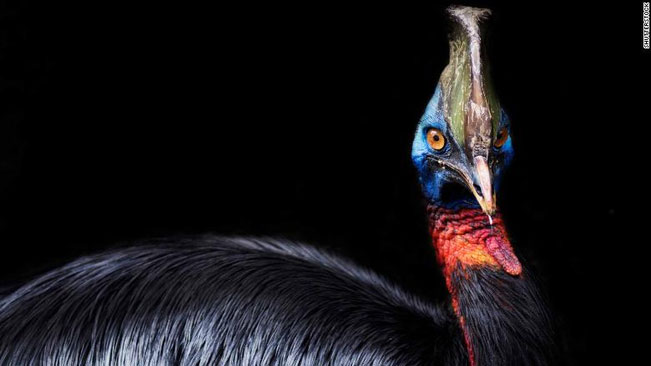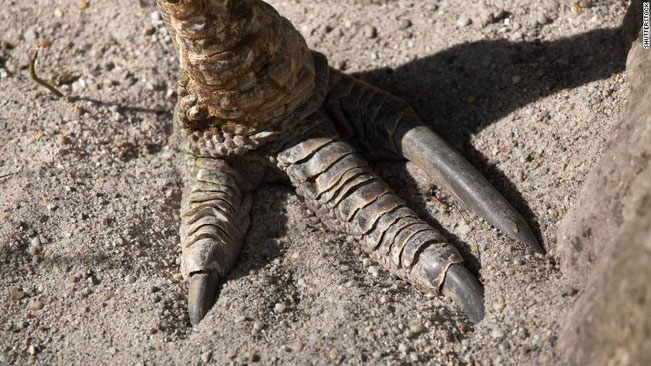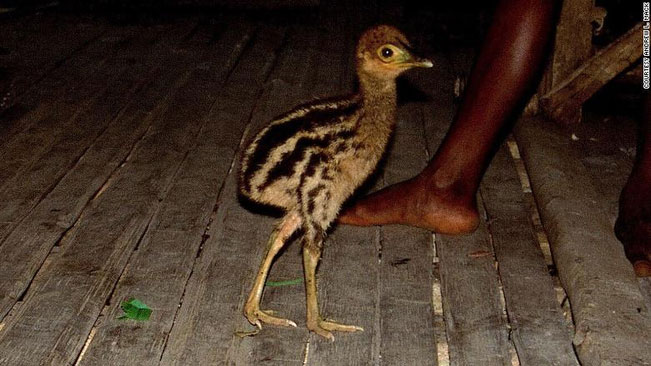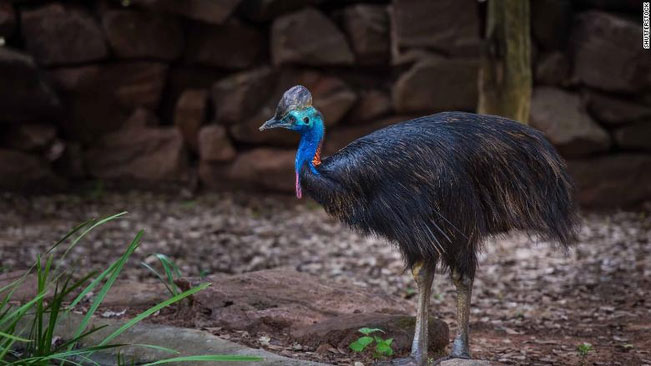The first bird species that humans may have domesticated could be the cassowary – often referred to as the most dangerous bird in the world – with dagger-like long toes.
This species is territorial, aggressive, and resembles a dinosaur. It is surprising that this bird was chosen for domestication.

This dangerous bird has been domesticated by humans for a long time.
First Evidence of Domestication
A recent study of over 1,000 fossilized eggshell fragments excavated from two rock shelters used by hunter-gatherers in New Guinea suggests that humans may have collected the eggs of this species before they hatched, incubated them until they hatched into chicks, and raised them to adulthood. New Guinea is a large island located north of Australia, with the eastern half belonging to Papua New Guinea and the western half to Indonesia.
“The behavior we found occurred thousands of years before chickens were domesticated,” said Kristina Douglass, the study’s author and an associate professor of anthropology and African studies at Penn State University.

Feet of the Southern cassowary, also known as the double-wattled cassowary. (Photo: CNN)
“And this is not a small bird; it is a large, colorful, flightless bird that can attack you,” she stated in a press briefing.
Researchers noted that while cassowaries can become aggressive (in 2019, a man in Florida was attacked and killed by one), they easily “imprint” and become attached to the first thing they see upon hatching. This allows humans to easily preserve and raise them to adulthood.
Today, the cassowary is the largest vertebrate species in New Guinea. Their feathers and bones are highly valuable materials in jewelry and ceremonial attire. The meat of the cassowary is also considered a delicacy in New Guinea.
The cassowary family has three species, all native to North Queensland, Australia, and New Guinea. Douglass suggests that our ancient ancestors likely domesticated the smallest species, the dwarf cassowary, which weighs around 20 kg.
During the study, scientists determined the carbon dating of the eggshells, which are approximately 6,000 to 18,000 years old. Humans are believed to have domesticated the first chickens no earlier than 9,500 years ago. Therefore, the domestication of cassowaries may have occurred thousands of years before that.

A young cassowary being raised indoors in New Guinea. (Photo: Andrew L. Mack).
Not for Eating Eggs
To reach this conclusion, researchers first analyzed eggshell samples from other living bird species such as turkeys, Australian emus, and African ostriches.
The inside of the eggshell changes as the chick extracts calcium from it. By using high-resolution 3D imaging and observing the inside of the eggshell, researchers were able to reconstruct the egg’s image at each incubation stage.
The scientists tested this model on the Australian emu and the African ostrich before applying it to the fossilized eggshell fragments found in New Guinea. The result showed that the fossilized eggshell samples were all near the mature stage.
“What we found is that most of the eggshells were harvested at a late stage. The eggshells looked very old; the selection was not random,” Douglass said.
Stealing cassowary eggs is inherently dangerous. The nests of these birds are often deep in the forest and quite hard to find. During the incubation period, male cassowaries guard the nest.
Being a highly territorial bird, the cassowary will certainly not spare anyone who intrudes on their territory, especially those daring enough to steal their eggs.
The study indicated that the people living in the two shelters harvested the eggs when the embryos had fully formed limbs, beaks, claws, and feathers.

The cassowary family has three species, all native to North Queensland, Australia, and New Guinea. (Photo: CNN)
But was the purpose of humans in collecting the eggs for incubation or for food? Douglass believes it may be for both.
Balut (fertilized eggs with fully formed embryos) is considered a delicacy in many parts of the world. However, she noted that the group’s analysis suggests it is highly likely that humans collected them for incubation purposes.
“We also looked for scorch marks on the eggshells. But with the number of late-stage eggshells showing no scorch marks, we cannot say they incubated the eggs and did not eat them.”
Legends from New Guinea also suggest that some ancient tribes here may have ridden cassowaries in their battles. However, according to Douglass, there is no evidence that these birds were domesticated by humans.
She stated that domestication requires human intervention in the existence of an entire species, similar to how the first chickens were bred from wild birds around 8,000 years ago.
With cassowaries, ancient people seemed to have only raised them without training them to be dependent or kept them close to humans, as they did with dogs and ibex goats.
Nevertheless, this remains the earliest evidence we have of poultry management and husbandry in human society. “Previously, we tended to think that this could only occur after humans developed agriculture,” Douglass said.
A Valuable Resource
Young eggshells show more scorch marks, indicating that when cassowary eggs were used as food, they would be cooked, and the inside would primarily remain liquid.
“Today, the people on the island raise cassowaries from young to large to collect feathers, consume, or sell them. It is possible that in the past, this bird also had high value, as it is the largest vertebrate on New Guinea. Raising cassowaries from young will provide a readily available source of feathers and meat, as hunting the mature animals in the wild can be difficult,” Douglass explained via email.
However, many questions remain unanswered by scientists.
To incubate and raise young cassowaries, humans would need to know their nesting locations, when the eggs are laid, and when they can be harvested just before hatching. This is not easy, as birds do not nest in the same place from year to year. Once the female lays eggs, the male will be responsible for incubating them and will not leave the nest for 50 days.
“Humans may have hunted male cassowaries and collected the eggs. Since the male does not leave the nest and does not eat much during the incubation process, they are very vulnerable to predation,” she said.
- The most dangerous bird in the world recognized by the Guinness World Records
- New discovery about the most dangerous bird in the world with dagger-like claws
- Student discovers strange object resembling fabric wrapping a mummified baby, experts’ explanation is astonishing
- Driven to the edge, a golden black snake frantically attacks a king cobra





















































